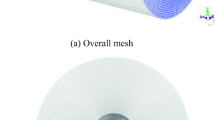Abstract
Three kayak paddle blades of different design (Conventional, Norwegian, Turbo) were tested in a low-speed wind tunnel at a maximum chord Reynolds number of Re = 2.2–2.7 × 105 (corresponding to speed through water of ≈1 m/s). The mean drag force and side force acting on each blade were measured, as the yaw and pitch angles were varied. The results were compared with those recorded for a finite rectangular flat plate of similar area and aspect ratio. For zero pitch angle of the blades, the results indicate that the drag coefficient was mostly independent of the blade design as the yaw angle was varied between ± 20°, with only the Norwegian blade design displaying a marginally higher drag coefficient than either of the other two blades or the flat plate. Increasing the pitch angle to 30°, while maintaining the yaw angle at zero, resulted in a 23% reduction of the drag coefficient for the flat plate, but only a 15% reduction of the drag coefficients for the three blades. For all designs, the drag coefficient reduction followed a simple cosine relationship as the pitch angle or yaw angle was increased. The wind tunnel experiments revealed that the side force coefficients for all three paddle blade designs were entirely independent of the blade design and were indistinguishable from those recorded for a flat plate. In summary, the study showed that the nondimensional force coefficients are largely independent of the paddle blade design.
Similar content being viewed by others
Abbreviations
- A:
-
Frontal area [m2]
- AR:
-
Blade aspect ratio [nondimensional]
- b:
-
Span [m]
- c:
-
Maximum chord [m]
- CD :
-
Mean drag force coefficient [nondimensional]
- CY :
-
Mean side force coefficient [nondimensional]
- FD :
-
Mean drag force [N]
- FY :
-
Mean side force [N]
- Re:
-
Reynolds number, based on maximum chord [nondimensional]
- U:
-
Freestream velocity [m/s]
- ϕ:
-
Aerodynamic yaw angle [o]
- μ:
-
Air viscosity [Ns/m2]
- θ:
-
Pitch angle [o]
- ρ:
-
Air density [kg/m3]
References
Aitken, D. & Neal, R. (1992) An on-water analysis system for quantifying stroke force characteristics during kayak events.International Journal of Sport Biomechanics,8, 165–173.
Bearman, P.W. (1971) An investigation of the forces on flat plates normal to a turbulent flow.Journal of Fluid Mechanics,46, 177–198.
Bearman, P.W. & Morel, T. (1983) Effect of turbulence on bluff body flows.Progress in Aerospace Sciences,20, 97–123.
Bell, W.H. (1986) Freestream turbulence and bluff body drag. In:Encyclopedia of Fluid Mechanics (ed. N. P. Cheremisinoff), Vol.1, pp. 453–475. Gulf Publishing Company, Houston.
Chen, J.M. & Fang, Y.-C. (1996) Strouhal numbers of inclined flat plates.Journal of Wind Engineering and Industrial Aerodynamics,61, 99–112.
Dal Monte, A. & Leonardi, L. (1976) Functional evaluation of kayak paddlers from biomechanical and physiological viewpoints. In:Biomechanics V-B (ed. P. Komi), International Series on Biomechanics, Vol.1B. pp. 258–270. University Park Press, Baltimore.
Dallos, F. (1980)Olympic Kayaking. Hampton Publishing Company, Chicago.
Fage, A. & Johansen, F.C. (1927) On the flow of air behind an inclined flat plate of infinite span. Aeronautical Research Council, Reports and Memoranda No. 1104.
Fail, R., Lawford, J. A. & Eyre, R. C. W. (1957) Low-speed experiments on the wake characteristics of flat plates normal to an air stream. Aeronautical Research Council, Reports and Memoranda No. 3120.
Hoerner, S.F. (1965)Fluid-Dynamic Drag; Practical Information on Aerodynamic Drag and Hydrodynamic Resistance. Published by S.F. Hoerner, Brick Town, N.J.
Kendal, S. & Sanders, R. (1992) The technique of elite flatwater kayak paddlers using the wing paddle.International Journal of Sport Biomechanics,8, 233–250.
Knisely, C.W. (1990) Strouhal numbers of rectangular cylinders at incidence: a review and new data.Journal of Fluids and Structures,4, 371–393.
Laneville, A., Garsthore, I. S. & Parkinson, G. V. (1975) An explanation of some effects of turbulence on bluff bodies. In:Proceedings of the Fourth International Conference on Wind Effects on Buildings and Structures (ed. K. J. Eaton), Heathrow, UK, pp. 333–341.
Mann, R. & Kearney, J. (1980) A biomechanical analysis of the Olympic style flatwater kayak stroke.Medicine and Science in Sports and Exercise,12, 183–188.
Plagenhoef, S. (1979) Biomechanical analysis of Olympic flatwater kayaking and canoeing.The Research Quarterly,50, 443–459.
Sumner, D. & Akosile, O.O. (2002) On a circular cylinder in a uniform planar shear flow at subcritical Reynolds number. To appear in:Proceedings of the 5th International Symposium on Fluid-Structure Interactions, Aeroelasticity, Flow-Induced Vibration & Noise, New Orleans, USA, Nov. 17–22, 2002, Paper No. IMECE2002-32170, New York: ASME.
Sumner, D. & Richards, M. D. (2003) Some vortex shedding characteristics of the staggered configuration of circular cylinders.Journal of Fluids and Structures, in press.
Sumner, D., Richards, M. D. & Heseltine, J. L. (2001) Mean aerodynamic forces acting on a pair of circular cylinders in cross-flow. In:Proceedings of the 31st AIAA Fluid Dynamics Conference & Exhibit, Anaheim, USA, AIAA Paper No. 2001-2850.
Zumerchik, J. (1997) Paddle Sports. In:Encyclopedia of Sports Science (ed. J. Zumerchik),Vol. 1., p. 333. Simon & Schuster Macmillan, New York.
Author information
Authors and Affiliations
Corresponding author
Rights and permissions
About this article
Cite this article
Sumner, D., Sprigings, E.J., Bugg, J.D. et al. Fluid forces on kayak paddle blades of different design. Sports Eng 6, 11–19 (2003). https://doi.org/10.1007/BF02844156
Issue Date:
DOI: https://doi.org/10.1007/BF02844156



